Alarifes Mudéjares / Eduardo Paniagua
Música para la iglesia mudéjar de San Martín de
Cuéllar
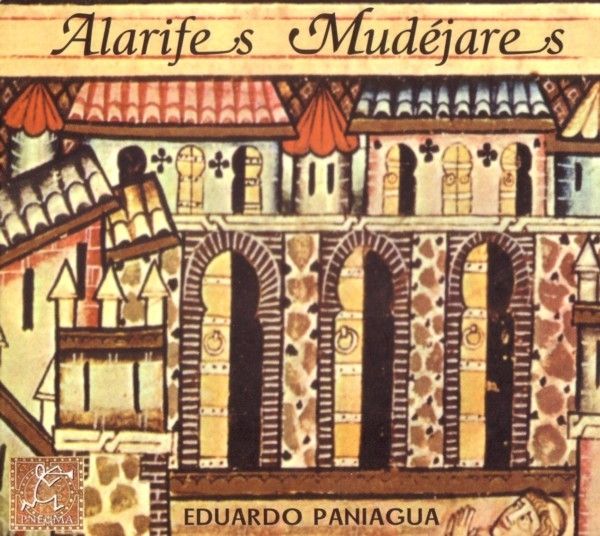
medieval.org
Pneuma «Colección Al-Andalus» PN-170
1999
1. Secuencia constructiva. Pilares, arcos, bóvedas [7:34]
Melodía sobre
original andalusí
modo Hiyáz oriental · ritmo: Qáim wa nisf
psalterio, flautas tenor y alto y cántara
teclado: arpa, santur, qanún, efecto base (emoción)
efectos: cantero, yesero, sierra de madera, yunque, grillos, ranas y
sapos
2. La barca. Tierra de nadie [2:50]
Melodía sobre
canto mozárabe ‘Surgam’
Antifonario de Silos
flauta tenor
teclado: efecto base, campanillas
efectos: barcos en el puerto
3. La fuente. Arte efímero-arte eterno [2:08]
Melodía sobre
original andalusí
modo Hiyáz oriental · ritmo: Qáim wa nisf
laúd, salamilla (flauta de caña), fahl (flauta
árabe metálica), darbuga y tar
teclado: dulcimer y pedal de efecto base
efectos: fuente de agua de jardín hispano-musulmán.
4. La alfombra. Arte colectivo y espacio colectivo [2:26]
Llamada a la
oración desde el alminar
cantor: Hasan Ajyar.
cantos de ceremonia judía, canto gregoriano: "Veni Creator
Spiritus"
campanas de iglesias: cercana y lejana
teclado: efecto base
5. Las velas. De pronto se llenó [6:56]
CSM 180
Melodía sobre
la cantiga 180
Cantigas de Santa María de Alfonso X el Sabio, siglo XIII
flauta travesera de catia, flauta tenor, santúr, viola,
campanillas y cántara
teclado: efecto base
6. Almuédano [3:19]
Llamada a la
oración andalusí
cantor: Said Belcadi
7. Yeserías [2:19]
Solo nay de sobre
modo andalusí
nay (flauta oblicua de caña)
8. Baños y aljibes [:39]
Canto libre
andalusí en los modos Rasd y Nahawand
cantor: Said Belcadi.
efectos: chorros de agua, bañera llenándose, gotas y
teclado base
9. Fiesta de Santa María [6:32]
CSM 411
Melodía sobre
la cantiga 411
Cantigas de Santa María de Alfonso X el Sabio, siglo XIII
viola, laúd, axabeba, fahl, cántara, darbuga y tar
teclado: efecto base
10. En el atrio [5:59]
Melodía de
nay sobre modo andalusí
nay, bendir y tambores
11. Albañil mudéjar [3:46]
Canto libre sobre
modo andalusí
cantor: Abedelhamid Al-Haddad
cántara, percusiones metálicas de darbuga
efectos: tallado sobre piedra, martillo sobre metal, martillo de forja
12. Capilla de azulejos [7:19]
CSM 418
Melodía sobre
la cantiga 418
Cantigas de Santa María de Alfonso X el Sabio, siglo XIII
viola, laúd, citolón, cistro, kaval, gaita charra, tar
y címbalos
teclado: efecto base
13. Oración de mediodía [2:30]
Canto de
almuédano andalusí
Abderrahim Abdelmoumen
efectos: niños en la plaza, pájaros, campanas de "angelus"
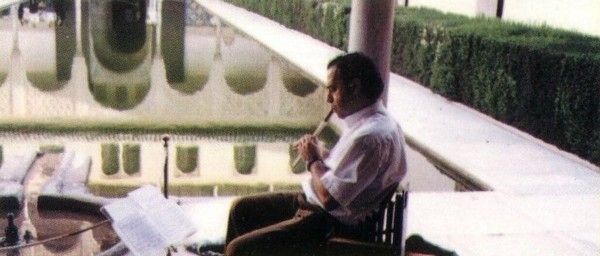
Canto andalusí:
Said Belcadi · Abedelhamid Al-Haddad · Hasan Ajiyar
· Abderrahim Abdelmoumen
Abdelouahíd Acha, nay
Jaime Muñoz, flauta travesera de caña
Wafir Sheik, laúd
Cesar Carazo, viola
Luis Vincent, cistro
Luis Paniagua, cántara
Luis Delgado, santur, citolón, laúd, bendir,
cántara
Enrique Almendros, gaita charra, campanillas y címbalos
Eduardo Paniagua
psalterio, flauta tenor y alto, salamilla (flauta de caña),
fahl (flauta árabe metálica),
darbuga, tar, címbalos, teclados/efectos/ambientes
Grabaciones realizadas en los años 1995, 1997 y 1999
Toma de sonido natural de los cantos: Eduardo Paniagua
Masterizado: Hugo Westerdahl - Axis, Madrid 1999
Agradecimiento a Luis Delgado por su apoyo en esta grabación
DDD ·
59:16
Portada: Cantigas de Santa María de Alfonso X el Sabio, s. XIII.
Detalle de construcción mudéjar de la miniatura 111
Contraportada e interior: Detalles de la iglesia de S. Martín de Cuéllar.
Diseño gráfico: Luis Vincent
Translation: Lesley Ann Shockhurgh
Depósito Legal: M-25643-1999
Distribución: Karonte, Madrid.
Producción: EDUARDO PANIAGUA • 1999 PNEUMA
PLAN DE DINAMIZACION TURÍSTICA •
CUÉLLAR
ISLA MUDÉJAR EN UN MAR DE PINARES
English liner notes
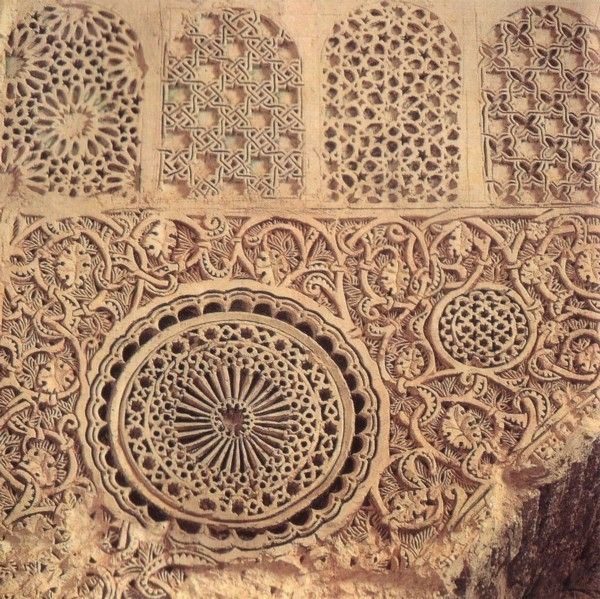
Alarifes Mudéjares
EDUARDO PANIAGUA
Música para la iglesia mudéjar de San Martín de
Cuéllar
La realidad histórica de la España medieval está
configurada por la convivencia de las tres castas: cristianos,
judíos y musulmanes.
Uno de los aspectos más sugerentes de esta integración se
manifiesta en el mudejarismo, entendido como proceso de
islamización de la sociedad hispánica desde la Edad Media
hasta siglos después, en la pervivencia de costumbres, oficios,
técnicas artesanales y manifestaciones artísticas.
Otro aspecto del mudejarismo es la influencia cristiana en los
musulmanes, criticada por los autores árabes de la época.
Imágenes emblemáticas de estas dos caras de la moneda son
las miniaturas de las Cantigas de Santa Maríia y del Libro de
Ajedrez, Dados y Tablas de Alfonso X el Sabio, con escenas de
musulmanes jugando con caballeros y damas cristianos y judíos.
Comúnmente se entiende como mudéjares, del árabe
"mudayyan", sometido o tributario, a los musulmanes que no emigraron y
permanecieron bajo el poder político de los reinos cristianos.
Como categoría artística el mudéjar se asimila al
arte románico y al gótico cristiano islamizado
profundamente, y no solo a la simple yuxtaposición de formas
decorativas islámicas sobre estructuras arquitectónicas
occidentales.
La selección, instrumentación y ambientación de la
música de este disco está inspirada en la iglesia
mudéjar San Martín de la ciudad de Cuéllar, en la
provincia de Segovia de la región de Castilla y Leon.
EDUARDO PANIAGUA
Cultura de Frontera
Tras la conquista de Toledo en 1085, Alfonso VI comenzó la
repoblación y la fundación de ciudades. "La tierra de
nadie se convirtió en tierra de todos." Y llegaron del norte:
Galicia, Tierra de Burgos, La Rioja, Navarra y Vasconia. Del sur: moros
de Toledo. De todas partes o de ninguna: los judíos.
Y se encontraron con algunos -pocos- que estaban desde hace tiempo:
descendientes de antiguas poblaciones árabes visigodas,
hispano-romanas e incluso con reminiscencias celtíberas.
Unos trajeron su saber trabajar la tierra, las técnicas de riego
o la albañilería, otros esperanzas y futuro y todos
dejaron casas, amigos, familias, hambre y paisajes. Entre todos
construyeron una cultura de frontera y una comunidad de hombres libres
"la comunidad de villa y tierra".
Tierra de Nadie
"Lo que dejaron y lo que trajeron..." Qué dejaron: barcas,
nieblas, hayedos, llaves de las casas, familias, amigos, ajuar, puertas
de las casas, redes. Qué trajeron: olores, colores, manos,
tecnologías, herramientas, religiones, canciones, niños,
semillas, amantes de la libertad y la fortuna, etc...
La Extremadura castellana, las tierras del río Duero, se
hicieron un espacio de convivencia. "Los hombres abandonaron sus
antiguos solares en busca de libertad y de fortuna, pero
jugándose la vida en el envite". "Un islote de gentes libres en
Castilla", pero los árabes que trajo Alfonso VI desde Toledo
eran "sometidos" mudéjares.
El Mudéjar, el arte más genuinamente español
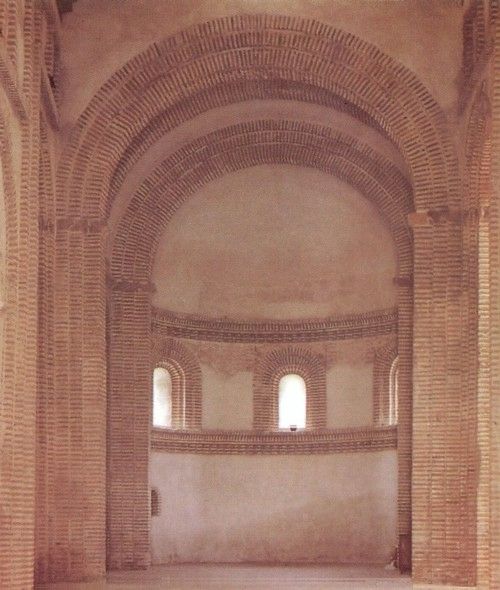 Un arte hecho de ventanas y puertas, de líneas
geométricas, de elementos decorativos -vegetales y
epigráficos- de repetición y ritmos, de oración
colectiva y espacio individual.
Un arte hecho de ventanas y puertas, de líneas
geométricas, de elementos decorativos -vegetales y
epigráficos- de repetición y ritmos, de oración
colectiva y espacio individual.
Lo decorativo no es superficial, tiene un profundo sentido. La ausencia
de iconografía, aunque el mudéjar la tiene
después, también tiene un sentido.
La albañilería mudéjar es la manifestación
artística genuina de un momento histórico en Castilla y
León que se concreta singularmente en Cuéllar.
La iglesia de San Martín refleja la belleza y el misterio de lo
vivido, de lo que se llenó, contempló, vibró y
tembló y ahora está vacío, callado.
Entrar en esta iglesia es comenzar un viaje. Un pequeño viaje
iniciático del que nunca se regresa impune, del que retornaremos
distintos, más viejos pero algo más sabios. Un viaje
hacia un universo, hacia un mundo singular, el de la frontera, el de la
mixtura y convivencia de culturas. En este recorrido nos adentramos en
la tierra de nadie, participamos en la emigración, compartimos
el abandono y la añoranza y el futuro y la esperanza -lo que
dejaron y lo que trajeron-, el descubrimiento del otro y el nacimiento
de la identidad, una cultura de "hombres libres" y "sometidos". Todas
esa memoria, esa cultura no está perdida sino atesorada en un
espacio vacío, en un ciudad, en unos rostros, en el fondo de
arena de unas miradas, de unos gestos, esperando ser redescubiertos.
Entrar en una iglesia mudéjar es penetrar en un universo donde
cada pieza tiene su sentido, es recuperar aromas, es abrir ventanas y
puertas, zaguanes que esconden olores y sabores, signos y
símbolos de tierra, marcas en la piel, canciones, juegos de
niños, memoria y recuerdo, sonidos de oraciones y gritos,
barrios, calles y espacios que habitaron sinagogas, que escucharon los
cantos de los muecines, de los soldados, de los clérigos, es
acercarse al punto donde la ciudad aunque parece dormida, palpita.
Arte efímero / arte eterno
"Los repobladores hubieron de improvisarlo todo..." y de esa vida de
frontera, de peligro, inseguridad y esperanza, fusión de
culturas y saberes surge este arte efímero, circunstancial,
humilde pero casi eterno. Las grandes piedras del páramo
están lejos, en tierra de peligro, de razias, y es mejor
utilizar materiales cercanos, básicos y humildes: arcilla,
barro, pequeñas piedras, agua, cal y madera.
La lana de las ovejas permitió la financiación y
así, unos pagaban -el concejo y el cabildo-, los alarifes
-albañiles árabes- dirigían y la comunidad -todos-
trabajaban.
Arte colectivo y espacio colectivo
La iglesia de San Martín de Cuéllar es una
creación colectiva, anterior a cualquier autor. Reflejo de una
sociedad comunitaria, de un tiempo y una cultura de
colaboración. Una sociedad de tres culturas.
Tres religiones distintas y un solo Dios verdadero. Aquí y con
diferentes rituales se celebraban los ciclos de la vida: la llegada al
mundo, los pasos del crecimiento, los compromisos, o la muerte. La
campana convivía con el muecín, la Biblia y el Talmud con
el Corán. La Navidad, la Cuaresma y el Ramadán,
Aid-elkebir o Bar-Mitzvah. La iglesia era Casa del Pueblo, espacio de
reunión y representación. Allí se conjuraban
pestes y se pregonaban rogativas. Se realizaban promesas y llegaban las
noticias. Era almacén (diezmos y primicias) y atrio para la
venta e intercambio. Lugar de exvotos y reliquias. Espacio de
reunión, hospitalidad y refugio. La escuela donde se
enseñaba a leer y a escribir.
Y además estaban las campanas y su lenguaje: toques de
oración (amanecer, angelus, atardecer, vísperas),
difuntos (diferentes para niños, hombres o mujeres), para
ahuyentar las nubes, reuniones colectivas y del concejo, toques de
rebato (peligros y socorros colectivos), las campanas del reloj y el
tiempo.
"Y de pronto se llenó..." Las iglesias que estuvieron desnudas
se llenaron de sonidos y objetos, los elementos decorativos se
combinaron con las imágenes.
Eusebio Leránoz
ICN-ARTEA

1. Constructive Sequence. Pillars, arches, vaults —
Melody based on an andalusi original. Mode: Oriental Hidyaz. Rhythm: Qaim wa nisf.
2. The Boat. No man's land —
Melody based on a Mozarabic song "Surgam" from the Antiphonary at Silos.
3. The Fountain. Ephemeral art-Eternal art —
Melody based on an andalusi original. Mode: Oriental Hidyaz. Rhythm: Qaim wa nisf.
4. The Carpet. Collective art and collective space —
Call to prayer from the minaret, voice: Hasan Ajyar.
Songs from the Jewish ceremony. Gregorian chant. "Veni Creator Spiritus" and bells.
5. The Candles. Suddenly it filled up —
Melody based on Cantiga 180 from Alfonso X's "Cantigas of Holy Mary".
6. Muezzin —
Andalusi call to prayer, voice: Said Belcadi.
7. Plasterwork —
Nay solo (an end-blown reed flute) in an andalusi mode.
8. Baths and cisterns —
Free andalusi song in the Rasd and Nahawand modes, voice: Said Belcadi.
9. Feast of Holy Mary —
Melody based on Cantiga 411, "Cantigas of Holy Mary", Alfonso X the Wise. XIII century.
10. In the Atrium —
Nay melody in an andalusi mode.
11. Mudéjar Bricklayer —
Free song in an andalusi mode, voice: Abedelhamid Al-Haddad.
12. Chapel of Tiles —
Melody based on Cantiga 415, "Cantigas of Holy Mary", Alfonso X the Wise. XIII century.
13. Midday Prayer —
Andalusi muezzin chant: Abderrahim Abdelmoumen.
Music for the Mudéjar church of St. Martin at Cuéllar
Spain's medieval history is marked by the coexistence of three civilizations - Christians, Jews and Muslims. Mudéjarism
represents one of the most relevant aspects of this integration,
surviving in customs, trades, arts and crafts, and defined as a process
of Islamization of Hispanic society through the Middle Ages and the
following centuries.
Another aspect of Mudéjarism is the Christian influence on the Muslims, criticized by Arab creators of the time.
The miniatures in Alfonso X's "Cantigas
of Holy Mary" and the "Book of Chess, Dice and Astronomical Tables",
with scenes of Muslims playing with Christian and Jewish Knights and
ladies, are emblematic of these two sides of the Mudéjar coin.
Normally the word Mudéjar
is used to describe the Muslims who did not emigrate and remained under
the political power of the Christian kingdoms. The word comes from the
Arabic, "mudayyan", meaning subjected or tributary.
As an artistic category the Mudéjar
resembles Romanesque art and profoundly Islamized Christian Gothic, and
is not simply the juxtaposition of Islamic decoration on western
architectural forms.
Mudéjar is not a style arising from
circumstance, but the artistic option of the expression of a culture,
different from European Christian art, chosen for the architecture of
churches and palaces, not only by the citizens, but also by the ruling
class.
The choice of the music for this recording, the instrumentation and atmosphere are inspired by the Mudéjar church of St. Martin in the town of Cuéllar, province of Segovia in the region of Castile and Leon.
EDUARDO PANIAGUA
Frontier Culture
After
the conquest of Toledo in 1085, Alfonso VI embarked on the repopulation
and founding of cities. "No man's land became everybody's land."
People
came from the north - Galicia, Burgos, La Rioja, Navarre and the Basque
Country. From the south - the Moors from Toledo. And the Jews came from
everywhere, or from nowhere.
These peoples found themselves with
other peoples, the few that had been there for some time, descendants
of ancient Arab, Visigoth, Hispano-Roman and even Celtic, settlements.
Some
brought knowledge of how to work the land, of irrigation techniques or
of bricklaying, others brought hope and future. They all left their
homes, friends, families, hunger and familiar landscapes. Between them
they built a frontier culture and a community of free men "the community
of town and land".
No man's land
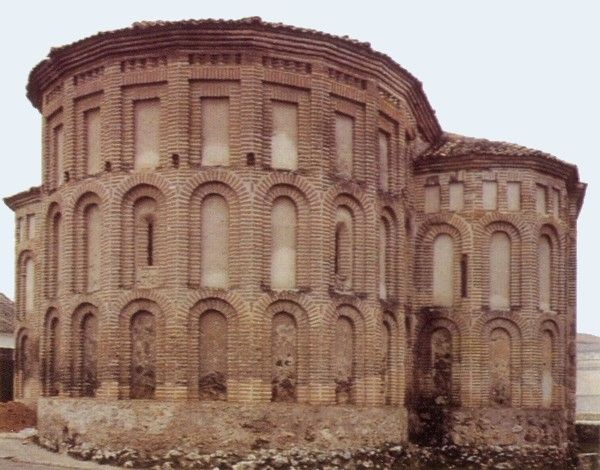
"What they
left and what they brought..." What they left - boats, fog, beech
groves, keys to their houses, families, friends, furnishings, doors,
nets. They brought smells, colours, hands, technology, tools, religions,
songs, children, seeds, lovers of freedom and fortune, etc...
The
Extremadura of Castile, the area around the river Duero, became an area
of coexistence. "Men abandoned their old land in search of freedom and
fortune, but they risked their lives in the attempt". "An island of free
peoples in Castile", but the Arabs that Alfonso VI brought from Toledo
were "subdued" Mudéjars.
Mudéjar, Spain's most genuine art form
An
art form comprising windows and doors, geometric lines, decorative
elements -plant motifs and epigraphs- repetition and rhythms, collective
prayer and individual space.
The decorative part is not superficial, it has a profound meaning. The absence of iconography, although found in later Mudéjar style, is also significant.
Mudéjar
brickwork is the genuine artistic manifestation of a historic moment in
Castile and Leon, which is cemented particularly in Cuéllar.
The
church of St Martin reflects the beauty and mystery of the life it has
seen, of what filled it, what it saw, what made it vibrate and tremble.
Now it is empty and quiet.
To go into this church is to start a
journey. A journey of initiation which will never leave you untouched,
from which we will return changed, older but a little wiser. A journey
towards the universe, towards a special world, a frontier world, that
represents the mixture and coexistence of cultures. On this journey we
enter no man's land. We join in the emigration, we share in the
abandonment and the nostalgia and the future and hope - what they left
and what they brought -, the discovery of something new and the birth of
an identity, a culture of "free men' and "subdued men". All these
memories, this culture, are not lost but accumulated in an empty space,
in a town, in faces, in the sandy depths of eyes and gestures, waiting
to be rediscovered. To go into a Mudéjar church is to penetrate a
universe where everything has a meaning. Aromas are rediscovered, doors
and windows are opened, revealing halls that hide smells and flavours,
signs and earth symbols, marks on the skin, songs, children's games,
memory and memories, sounds of prayer and shouts, neighbourhoods,
streets and spaces once occupied by synagogues, spaces that heard the
chants of the muezzins, of the soldiers, of the clerics. We approach the
point where the town, whilst appearing to be asleep, beats.
Ephemeral art/eternal art.
"The
people who repopulated had to improvise everything..." and from this
frontier life, a life of danger, insecurity, and hope, a fusion of
cultures and wisdom, emerges this ephemeral art, circumstantial, humble
but almost eternal.
The great stones of the plain are far away,
in a land of danger, of forays, and it is better to use materials that
are close by, basic and humble - clay, mud, pebbles, water, lime and
wood.
Wool from the sheep provided the money, and thus some paid
the town council - whilst Arab bricklayers gave the orders, and the
community -everybody- worked.
Collective art and collective space
The
church of St Martin at Cuéllar is a collective creation, prior to any
creator. It reflects a community society, at a time and in a culture of
collaboration. A society of three cultures.
Three different
religions and one true God. Here the cycles of life were celebrated with
different rituals - arrival in the world, growing up, maturity, or
death. The bell lived in harmony with the muezzin, the Bible and the
Talmud with the Koran. Christmas, Lent and Ramadan, Aidelkebir or
Bar-Mitzvah. The church was the House of the People, a space to meet and
a place of representation. Curses were pronounced and prayers said.
Promises were made and news arrived. It was a warehouse (tithes and
first-fruits) and the place for selling and exchange. A place for ex votos
and relics. A space for meetings, hospitality and refuge. The school
where reading.and writing was taught. There were the bells and their
language - peals for prayer (at dawn, angelus, evening, vespers), for
the deceased (one for children, another for men or women), peals to
disperse the clouds, to call a meeting and to convene Council, peals of
alarm (collective dangers and distress), to tell the time and give a
weather forecast.
"And suddenly it filled up..." The churches
that were naked were filled with sounds and objects, the decorative
elements combined with the images.
Eusebio Leránoz, ICN-ARTEA




 Un arte hecho de ventanas y puertas, de líneas
geométricas, de elementos decorativos -vegetales y
epigráficos- de repetición y ritmos, de oración
colectiva y espacio individual.
Un arte hecho de ventanas y puertas, de líneas
geométricas, de elementos decorativos -vegetales y
epigráficos- de repetición y ritmos, de oración
colectiva y espacio individual.

